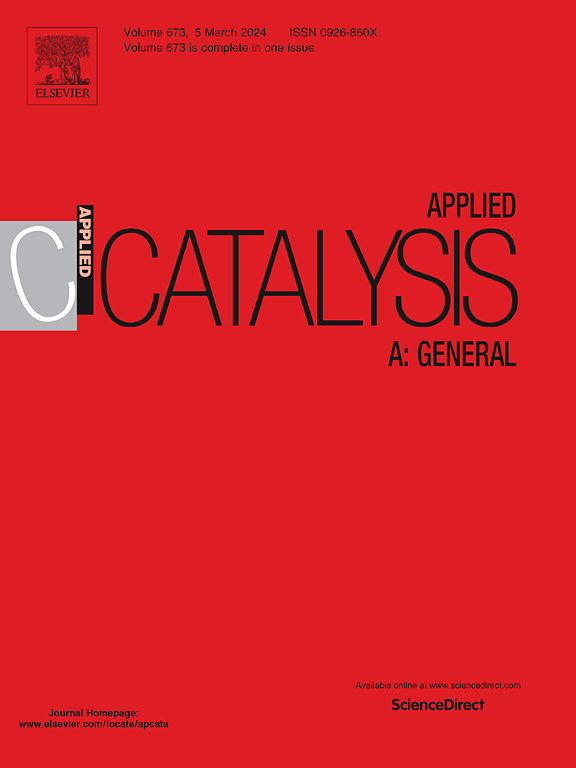Furfural oxidation by hierarchical titanium silicate catalyst with NiO nanoparticles: Improved diacid yield and elucidation of reaction pathway
IF 4.8
2区 化学
Q2 CHEMISTRY, PHYSICAL
引用次数: 0
Abstract
Oxidation of biomass-derived furfural with hydrogen peroxide provides a sustainable path to 1,4-diacids for polymer production. The state-of-the-art catalyst, titanium silicate (TS-1), suffers from drawbacks including deactivation and diffusion limitations, but its catalytic activity can be improved by introducing mesoporosity and metal species. Herein, hierarchical TS-1 (HTS-1) catalysts loaded with different metal oxides were prepared and examined for furfural oxidation with aqueous hydrogen peroxide. HTS-1 loaded with Ni (Ni/HTS-1) yielded 32 % maleic acid from furfural under screening conditions, which was 28 % higher relative yield than unloaded HTS-1 under the same conditions. Catalyst characterization and an in situ 13C NMR study elucidated the promotional role of Ni and the pathway, by which the reaction proceeds. Surprisingly, the NMR study indicated that the reactions using both Ni/HTS-1 and unloaded HTS-1 proceed via formation of furfural peroxide followed by Baeyer-Villiger oxidation, and not via epoxidation as many other TS-1 catalyzed oxidations.
纳米NiO纳米颗粒催化层状硅酸钛氧化糠醛:提高二酸产率及反应途径的阐明
用过氧化氢氧化生物质衍生的糠醛为聚合物生产提供了一条可持续的途径。最先进的催化剂硅酸钛(TS-1)存在失活和扩散限制等缺点,但可以通过引入介孔和金属种类来提高其催化活性。本文制备了负载不同金属氧化物的分级TS-1 (HTS-1)催化剂,并对其在过氧化氢水溶液中氧化糠醛进行了研究。负载Ni的HTS-1 (Ni/HTS-1)在筛选条件下从糠醛中提取马来酸的收率为32 %,比未负载的HTS-1在相同条件下的相对收率高28 %。催化剂表征和原位13C NMR研究阐明了Ni的促进作用和反应进行的途径。令人惊讶的是,核磁共振研究表明,使用Ni/HTS-1和卸载HTS-1的反应都是通过形成糠醛过氧化物然后进行Baeyer-Villiger氧化,而不是像许多其他TS-1催化的氧化一样通过环氧化。
本文章由计算机程序翻译,如有差异,请以英文原文为准。
求助全文
约1分钟内获得全文
求助全文
来源期刊

Applied Catalysis A: General
化学-环境科学
CiteScore
9.00
自引率
5.50%
发文量
415
审稿时长
24 days
期刊介绍:
Applied Catalysis A: General publishes original papers on all aspects of catalysis of basic and practical interest to chemical scientists in both industrial and academic fields, with an emphasis onnew understanding of catalysts and catalytic reactions, new catalytic materials, new techniques, and new processes, especially those that have potential practical implications.
Papers that report results of a thorough study or optimization of systems or processes that are well understood, widely studied, or minor variations of known ones are discouraged. Authors should include statements in a separate section "Justification for Publication" of how the manuscript fits the scope of the journal in the cover letter to the editors. Submissions without such justification will be rejected without review.
 求助内容:
求助内容: 应助结果提醒方式:
应助结果提醒方式:


